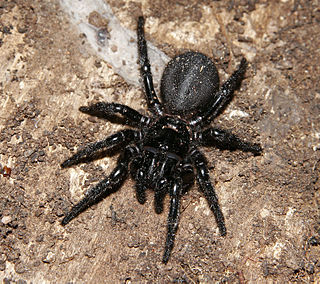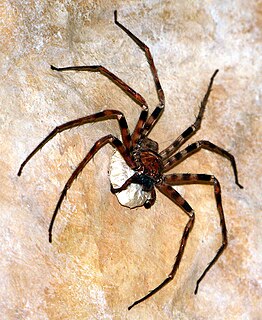
Amaurobiidae is a family of three-clawed cribellate or ecribellate spiders found in crevices and hollows or under stones where they build retreats, and are often collected in pitfall traps. Unlidded burrows are sometimes quite obvious in crusty, loamy soil. They are difficult to distinguish from related spiders in other families, especially Agelenidae, Desidae and Amphinectidae. Their intra- and interfamilial relationships are contentious. According to the World Spider Catalog, 2019, the family Amaurobiidae includes about 275 species in 49 genera.

Hadronyche is a genus of venomous Australian funnel-web spiders that was first described by L. Koch in 1873. Originally placed with the curtain web spiders, it was moved to the Hexathelidae in 1980, then to the Atracidae in 2018.

Gradungulidae, also known as large-clawed spiders, is a spider family endemic to Australia and New Zealand. They are medium to large-sized haplogyne spiders with three claws and two pairs of book-lungs similar to Mygalomorphae. Some species build extensive webs with an upper retreat tangle and connecting threads to scaffolding. This supports the ladder-like catching platform that is glued to the ground. Progradungula, a large spider with long legs like Hickmania, and Macrogradungula are the only cribellate genera of the family.

Badumna is a genus of intertidal spiders that was first described by Tamerlan Thorell in 1890. They are harmless spiders that can be found around human structures and buildings. They are darkly colored, usually with a lighter colored pattern on the abdomen. The most well-known species is B. insignis, also known as the "black house spider" or "black window spider".

Heteropoda is a genus of spiders in the family Sparassidae, the huntsman spiders. They are mainly distributed in tropical Asia and Australia, while at least one species, H. venatoria, has a cosmopolitan distribution, and H. variegata occurs in the Mediterranean.
Habronestes is an ant-eating spider genus that occurs only in Australia.

Isopeda is a genus of huntsman spiders that was first described by Ludwig Carl Christian Koch in 1875.
Oztira is a genus of Australian tangled nest spiders first described by G. A. Milledge in 2011.
Gippsicola is a genus of Australian tube dwelling spiders that was first described by Henry Roughton Hogg in 1900. It is no longer considered a junior synonym of Segestria due to anatomical differences in the pedipalps of males and the receptaculum in females.

Dolophones is a genus of orb-weaver spiders first described by Charles Athanase Walckenaer in 1837.

Isopedella is a genus of huntsman spiders that was first described by D. B. Hirst in 1990.

Neosparassus is a genus of huntsman spiders first described by Henry Roughton Hogg in 1903. Members of this genus most closely resemble those of Heteropoda, except that the cephalothorax is high, peaking between the midpoint and the eyes, before sloping toward the back. This angle causes the front of these spiders to appear more prominent than it actually is.
Anzacia is a genus of South Pacific ground spiders that was first described by R. de Dalmas in 1919.








